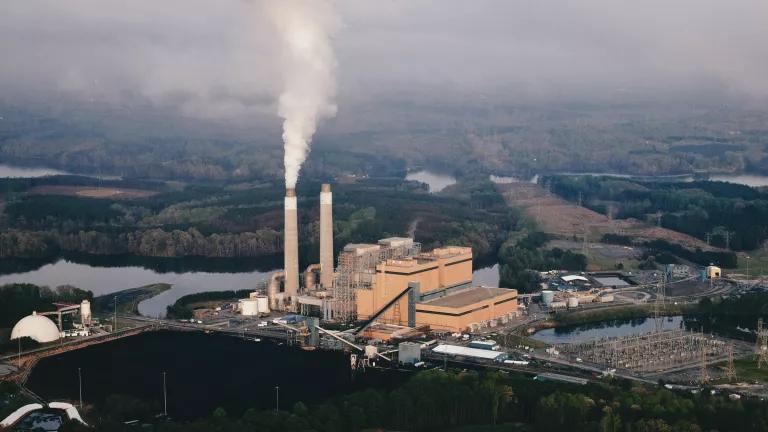FERC Can't Just Check the Climate Box

Federal law requires that the Federal Energy Regulatory Commission (FERC) take a “hard look” at a proposed energy’s project’s effect on climate change. In last week’s order approving the Calcasieu Pass liquefied natural gas (LNG) export facility in Cameron Parish, Louisiana, FERC adopted what it called a “new approach for consideration of direct greenhouse gas emissions from LNG facilities.”
FERC’s “new approach”—applied over Commissioner Richard Glick’s dissent—falls far short of what is required under both the Natural Gas Act and the National Environmental Policy Act (NEPA). The order is unreasoned, arbitrary, and fails to include a robust public interest analysis. It reads as though FERC is trying to check the climate box and move on.
The legal history behind FERC’s consideration of greenhouse gases is complicated. But FERC’s statutory duty for reviewing LNG facilities is clear: FERC must determine both whether the project is consistent with the public interest and consider the direct and cumulative greenhouse gas effects caused by an LNG facility.
In the Calcasieu Pass order, FERC does neither.
How we got here
There is a “tangled web of regulatory processes” involved in permitting LNG facilities. FERC reviews the siting and construction of LNG terminals. It does not, however, approve the exporting (or importing) of gas via those terminals; that decision rests exclusively with the Department of Energy. This is different from interstate pipelines, where FERC determines the siting and construction of the pipeline, as well as whether gas can flow inside it.
This division of labor affects how NEPA is applied to LNG facilities. NEPA requires agencies to consider the direct, indirect, and cumulative effects caused by a proposed action, including its effects on greenhouse gas emissions (see here for an explanation of direct, indirect, and cumulative effects). The key word here is “caused.”
In the pipeline context, caselaw establishes that, at least when the end-users are known, downstream greenhouse gas emissions are an indirect effect of FERC’s action, because FERC decides whether the gas arrives at the end-user to be burned. That means that FERC must consider these effects in its pipeline NEPA analyses.
Conversely, in the LNG terminal context, caselaw establishes that downstream greenhouse emissions are not indirect effects that FERC must consider under NEPA, because FERC only approves the LNG terminal and not the exporting or importing of the gas. Since DOE is the agency that decides whether the gas is imported or exported, DOE enables its use.
For both pipelines and LNG terminals, FERC must, however, consider the direct and cumulative effects of its actions. In the LNG terminal context, this means that FERC must consider the greenhouse gases caused by the construction and operation of the LNG terminal itself, and the cumulative impacts that the construction and operation of the LNG terminal itself has when added to other past, present or likely future actions in the same region (i.e., other nearby LNG terminals). In some cases, the cumulative effects can be the “straw that breaks the camel’s back” in determining the environmental impact of a project.
Simply disclosing the pure statistics isn’t enough. FERC must also determine the “significance”—a term of art within NEPA—of these effects. This is because numbers, in and of themselves, do not answer whether something is a significant environmental impact or not. For example, if a project were to emit a lot of oxygen into the atmosphere, that presumably would be less significant than if it were to emit a small amount of methane.
How FERC failed
The lead opinion of the Calcasieu Pass order—joined by FERC Chairman Neil Chatterjee and Commissioner Bernard McNamee—asserts that the construction and operation of the Calcasieu Pass LNG facility could directly increase annual emissions of carbon dioxide equivalent (CO2e) by nearly 4 million metric tons. It then states that such a result would increase overall U.S. CO2e emissions by 0.07 percent.
Is this a significant amount? The order never says, nor does it explain what this number is even being used to support. Instead, the order simply discloses this statistic, and then backpedals with the blanket statement that “there are no national targets to use as a benchmark for comparison,” citing the Trump administration’s intention to repeal the Clean Power Plan and withdraw from the Paris Agreement. In other words, a proposed change in policy by the current administration seemingly drove FERC’s conclusion that it couldn’t assess significance.
As it is, the 0.07 percent figure reads as an aside, or what lawyers call dicta: material, that, while interesting, is not being used to decide anything.
After citing the 0.07 percent figure, the order acknowledges unequivocally that construction and operation of the LNG terminal “will contribute incrementally to climate change.” Further, FERC staff’s Environmental Impact Statement for the project makes the connection between greenhouse gas emissions and climate change, stating that climate change is “driven by accumulation of [greenhouse gases] in the atmosphere through combustion of fossil fuels … combined with agriculture and clearing of forests.” However, FERC concludes that it cannot determine whether the “project’s contribution to climate change would be significant” due to the alleged lack of an accepted methodology for doing so. This is the end of the order’s climate change inquiry. The order doesn’t even attempt to address cumulative greenhouse gas effects. While McNamee said that FERC gave the project’s climate impacts “thoughtful consideration,” it’s hard to tell from the order itself.
Here’s where things get weird: after concluding that FERC cannot assess the significance of these acknowledged greenhouse gas emissions, Chatterjee and McNamee declare that “all impacts from construction and operation of the facilities will be reduced to less than significant levels” if the terminal is built in accordance with the order. (Emphasis added.)
This makes no sense: If FERC says that it cannot determine the significance of the project’s direct greenhouse gas emissions, how can FERC know that they’ll be reduced to less than significant levels?
This inconsistency suggests one of two things. Either (1) FERC is making a major logical misstep; or (2) FERC did, in fact, determine that the project’s greenhouse gas emissions were insignificant, without explaining its method for doing so. This latter theory is strengthened by FERC’s declaration that it used a “new approach” for evaluating the project’s greenhouse gas emissions.
What was the new approach? The inclusion of the 0.07 percent figure? Because, if so, that’s a big problem for FERC, since it’s claimed in the past that because it’s “not aware of a widely accepted standard … to ascribe significance,” it would be arbitrary to pick one without some level of scientific acceptance or explanation. In fact, in the often-cited Sabal Trail case, the D.C. Circuit ordered FERC to “either quantify and consider the project's downstream carbon emissions or explain in more detail why it cannot do so.” In response, FERC stated that it could not determine significance due to the alleged lack of an established method for doing so. If FERC is now making a significance determination based on the project’s impact on national emissions, it needs to disclose that and explain how it did so. Failing to do so is arbitrary and capricious under NEPA.
Time’s up
FERC has been waffling on how to consider a project’s climate change effects for years. As Glick wrote in his dissent, “no one benefits from the Commission’s refusal to take climate change seriously.” FERC needs to stop trying to just check a box and instead adopt a robust analysis.



